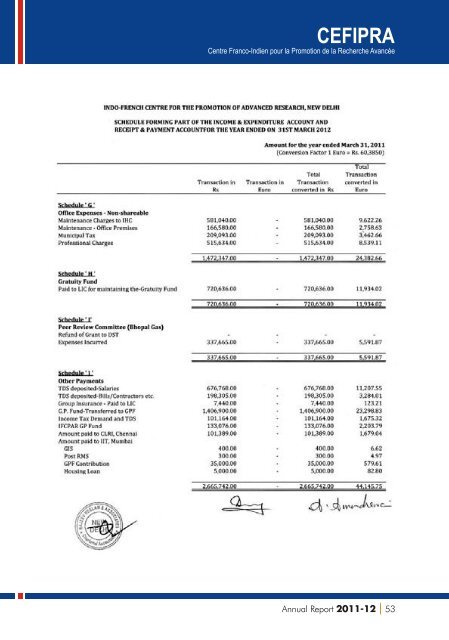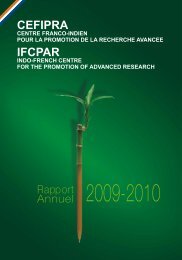IFCPAR AR (ENGLISH) for CD - CEFIPRA
IFCPAR AR (ENGLISH) for CD - CEFIPRA
IFCPAR AR (ENGLISH) for CD - CEFIPRA
You also want an ePaper? Increase the reach of your titles
YUMPU automatically turns print PDFs into web optimized ePapers that Google loves.
<strong>CEFIPRA</strong><br />
Centre Franco-Indien pour la Promotion de la Recherche Avancée<br />
Duration: Three years (September, 2010 to August, 2013)<br />
One of the main goals of observational cosmology is to find<br />
answers to questions such as how star-<strong>for</strong>mation proceeds,<br />
what is the resultant metal production, how it is related to the<br />
physical and chemical state of the interstellar medium (ISM)<br />
and what is the mode of transport of metals from the galaxies to<br />
the IGM. Absorption lines seen in the spectra of high-redshift<br />
quasars are very sensitive tracers of the gas located in dense<br />
regions like disks of galaxies as well as in diffuse intergalactic<br />
medium.<br />
Objectives<br />
i) the molecular and dusty interstellar medium of distant<br />
galaxies<br />
ii) the multiphase structure of the neutral gas probed by 21cm<br />
absorption<br />
iii) the metal enrichment of the IGM and its connection to<br />
outflows from galaxies and QSOs and (iv) to constrain the<br />
time variation of different dimensionless fundamental<br />
constants<br />
Accomplishments<br />
Project 4304-2<br />
INTERSTELL<strong>AR</strong> AND INTERGALACTIC MEDIUM AT HIGH REDSHIFT:<br />
RESERVOIR FOR GALAXY FORMATION<br />
i) Precise measurement of the temperature of the Cosmic<br />
microwave background radiation using a sample of high<br />
CO absorbers<br />
ii) Constructing a biggest sample of intervening OVI<br />
absorbers in the redshift range<br />
iii) Completing a systematic measurement of variation of<br />
fundamental constants at high redshifts using 21-cm<br />
absorption lines<br />
iv) A systematic monitoring of 25 broad absorption line QSOs<br />
with IGO near Pune. This has resulted in the first detection<br />
of line variability in a BAL QSOs that show absorption due<br />
to excited fine-structure lines<br />
v) A systematic survey of 21-cm absorption over the redshift<br />
range 0.5 to 1.0 and 2.9 to 3.5 using GBT, GMRT and<br />
WSRT has been completed. The data analysis is underway<br />
Research papers published: One<br />
Research Activities 2010-11<br />
Pure and Applied Physics<br />
Prof. R. Srianand<br />
Inter-University Center <strong>for</strong> Astronomty<br />
& Astrophysics (IUCAA)<br />
Pune<br />
Prof. P. Petitjean<br />
Institut d' Astrophysique de Paris<br />
Paris<br />
53





